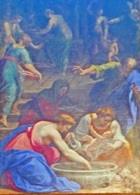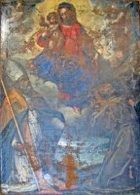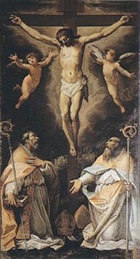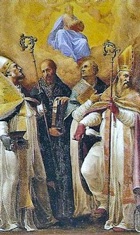Cristoforo Roncalli was born at Pomarance, near Volterra and is known as il Pomarancio. He shares this nickname with two other artists:
-
✴Nicolò Circignani, under whom Cristoforo trained; and
-
✴Nicolò’s son, Antonio Circignani, whom Cristoforo Roncalli seems to have helped professionally after his father’s death in ca. 1596.
Cristoforo Roncalli moved to Rome in 1578. He worked for Pope Gregory XIII in 1580-5 in the Vatican and Quirinal Palaces. He enrolled in the Accademia di San Luca in 1588.
The two most important commissions in the latter part of his career were:
-
✴the decoration of Pope Clement VIII's chapel in St. Peter's in 1599-1604, including the painting of a huge slate altarpiece of the Death of Ananias and Saphira; and
-
✴the execution of the frescoes (1605-10) in the Sacrestia Nuova (now the Sala del Tesoro) of the Santuario della Santa Casa di Loreto.
He was made a Cavaliere di Cristo in 1607.
Cristoforo Roncalli, the Oratorian Fathers and the Crescenzi Family
By the mid-1580s, Cristoforo Roncalli had become both personally and professionally involved with the Oratory of St Philip Neri in Santa Maria in Vallicella. When St Philip Neri died in 1595, Cristoforo Roncalli was commissioned to paint ten scenes from his life and posthumous miracles (1596-9) in the Cappella di San Filippo Neri in Santa Maria in Vallicella.
This brought him into contact with important Roman families such as the Mattei, Giustiniani and, in particular, the Crescenzi. According to Giovanni Baglioni, Cristoforo Roncalli ran an academy at the Palazzo Crescenzi in Rome, which belonged to Virgilio Crescenzi. Virgilio’s son, the amateur artist Giovanni Battista Crescenzi, studied there.
Cristoforo Roncalli had a close relationship with another of Virgilio’s sons, Giacomo Crescenzi. Both men were close to St Philip Neri, and each of them features in a posthumous miracle that was recorded in Father Bacci’s “Life of St Philip Neri” (1622):
-
✴When a son of Alessandro Presciati lay dying, the family sent for “Cristoforo Roncalli, commonly called Il Pomarancio, a painter of considerable note” to paint his portrait. His brother, apparently called Donato Roncalli prayed to St Philip Neri and the child recovered.
-
✴“Abate Giacomo Crescenzi, who was suffering from weakness of stomach [was] instantly cured by the application of one of [St Philip Neri’s] skull-caps”.
Cristoforo Roncalli and Umbria
Two factors in particular occasionally brought Cristoforo Roncalli to Umbria:
-
✴a branch of his family had settled in Foligno; and
-
✴his friend, Giacomo Crescenzi (above), who held the Abbazia di San Eutizio, Norcia in commendam in 1586-1637, commissioned a number of works from him (see below).
Assisi
Birth of the Virgin (ca. 1605)

The presence of Cristoforo Roncalli in this chapel is almost certainly associated with the fact that it belonged to a branch of his family that had settled in Umbria. He probably suggested the young Antonio Circignani (see above) for the work on the frescoes of the chapel, which was probably complete by the time that the altarpiece was painted.
Foligno
Madonna and Child in glory with saints (1598)

The altarpiece was cut down and badly damaged in the 19th century when it was moved to the sacristy. It is now in the Museo Diocesano.
Apollo (ca. 1613)
This panel, which is attributed to Cristoforo Roncalli, is inserted in the stucco ceiling of what seems to have been the music room of Palazzo Jacobilli-Roncalli (at number 9 Corso Cavour, now the premises of the Ciani Group). (This room is almost the only surviving part of the original palace, which Giovanni Martino Roncalli built in ca. 1600).
Norcia
Crucifixion with saints (1602)

Madonna in Glory with saints (early 17th century)

The altarpiece depicts the Virgin in clouds, with:
-
✴St Eutychius, who holds the reliquary that contained his hair shirt, which Pope Gregory I reported had Norcia from a draught in the time of the Lombards;
-
✴(probably) St Florentius;
-
✴St Sanctulus (identified on the book that he holds), the priest and friend of Pope Gregory I who protected Norcia from its Lombard occupiers in the 6th century; and
-
✴St Spes, with the dove that flew from his mouth as he died.
The choice of these local saints suggests that the altarpiece was part of what turned out to e an unsuccessful campaign to restore the episcopal status of Norcia in the early 17th century.
Perugia
Frescoes (early 17th century)
These frescoes in the presbytery of the ex-church of Santa Caterina Vecchia, which are attributed to Cristoforo Roncalli, depict:
-
✴the Trinity with saints and angels, in the cupola; and
-
✴the four Evangelists, in the pendentives.
The presence nearby of the arms of the Cantagallina family suggest that they might have been associated with the commission: Orazio Cantagallina made other donations to the nunnery in 1603-13, when his two daughters were nuns here.
Read more:
For the frescoes in Santa Caterina Vecchia, see:
L. Teza, “La Pittura a Perugia nel Primo Seicento: Note sul Roncalli e sul Sermei”, Esercizi 6 (1983) 48-61
Return to Art in: Assisi Foligno Norcia Perugia.
Return to “Foreign” Painters in Umbria.



